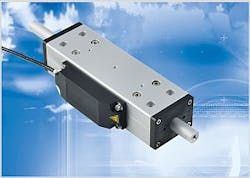Based on the company's PILine ultrasonic ceramic motor, the M-272 linear actuator from Physik Instrumente (PI; Auburn, MA) for automation applications combines a motor, actuator, linear encoder, guiding system and brake functionality. Features include a 50 mm travel range, 5 µm resolution, and travel speed at 200 mm/sec.
-----
PRESS RELEASE
Fast Linear Actuator for Automation is Based on Ultrasonic Motor Technology
Auburn, MA -- piezo motor specialist PI introduces the new M-272 linear actuator for automation applications based on a maintenance-free PILine® ultrasonic ceramic motor.
PILine® piezo ceramic ultrasonic drives offer an affordable alternative to electromagnetic linear motors and motor-leadscrew combinations when small dimensions and/or high speed are important. With velocities of up to 200 mm/s, these drives are fast, compact, and are readily integrated. In addition, PIline® motors are self-locking at rest with zero heat generation, eliminating the need for an additional motor brake.
The novel M-272 closed-loop linear drive combines motor, actuator, linear encoder, guiding system and brake functionality in a very compact package. Due to the integrated guiding system a payload can be easily attached to the drive rod of the M-272 drive and positioned precisely.
Features and Advantages
- Maintenance Free Ceramic Linear Motor
- Travel range 50 mm
- 5 µm Resolution with Integrated Linear encoder
- Fast: 200 mm/sec (8”/sec)
- High Speed and Dynamics for fast Settling
- Self-Locking at Rest, no need for External Brakes, no Energy Consumption.
- OEM Driver Electronics for Ultrasonic Motors Available
Patented Technology: Self-locking Instead of Quiescent Current
PILine® piezo motors are based on a new, patented, ultrasonic drive principle developed by PI. The core piece of the system is a piezoceramic plate, excited with high-frequency eigenmode oscillations. A friction tip attached to the plate moves along an inclined linear path at the eigenmode frequency. Through its contact with the ceramic friction bar (runner), the moving part of the mechanical system is pushed along. With each oscillatory cycle, the mechanical system executes a minute step of only a few nanometers; the macroscopic result is smooth motion with a virtually unlimited travel range. The piezo ceramic plate is preloaded against the runner and thus generates the holding force when the drive is at rest. The technology is in part protected by the following patents: US Pat. No. 6,765,335, German Patent No. 10154526
Controller for Faster Settling with Dynamic Control Parameter Adaption
The linear actuator can be driven with the C-867.OE OEM controller card. Its highly specialized DSP handles all of the motion properties typical for ultrasonic piezomotors, such as dynamic control parameter adaption. Optimized settling behavior of the mechanics within 10s of milliseconds is achieved by automatically switching between gainsets for dynamic and static operation.
Additional information on ultrasoinc motors is available at
http://www.ultrasonic-motor.com/Ultrasonic_Motors_Catalog.pdf
-----
Posted by Lee Mather
Follow us on Twitter, Facebook, and LinkedIn
Follow OptoIQ on your iPhone; download the free app here.
Subscribe now to BioOptics World magazine; it's free!
